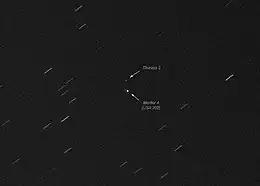.jpg.webp)



Orion, also known as Mentor or Advanced Orion,[1] is a class of United States spy satellites that collect signals intelligence (SIGINT) from space. Operated by the National Reconnaissance Office (NRO) and developed with input from the Central Intelligence Agency (CIA), eight have been launched from Cape Canaveral on Titan IV and Delta IV launch vehicles since 1995.
These satellites at geostationary orbits collect radio emissions (SIGINT) and act as replacements for the older constellation of Magnum satellites. The satellites have estimated mass close to 5,200 kg and very large (estimated 100 m diameter)[2] radio reflecting dishes. USA-223 (NROL-32), which is seen as the fifth satellite in the series, is according to NRO director Bruce Carlson "the largest satellite in the world."[3] It is believed that this refers to the diameter of the main antenna, which might be well in excess of 100 m (330 ft).[4] The mission and capabilities of these satellites are highly classified, though targets may include telemetry, VHF radio, cellular mobile phones, paging signals, and mobile data links.[5] Earlier satellites with similar missions, the Rhyolite/Aquacade series, were built by TRW; it is not known who made the Orion satellites.[6]
Satellites
Mentor-4 (USA-202) deployment and initial westward drift after launch in January 2009 was controlled by the Pine Gap base. About 60 days after launch Menwith Hill Ground Station was to take over control and initiate the collection mission. Mentor-4's initial mission was to survey line-of-sight microwave towers and emitters in the People's Republic of China for 30 to 45 days as it was drifting from east to west. Moving further west, it was to collect data from the Thuraya network and monitor Pakistan and Afghanistan, followed by another 200 days of monitoring of China. This was to be followed by data collection covering the Middle East, Northern Africa, and Latin America.[7][8]
| Name | COSPAR ID | Launch date (UTC) |
Launch vehicle | Launch site | Launch designation |
Longitude | Remarks |
|---|---|---|---|---|---|---|---|
| USA-110 | 1995-022A | 14 May 1995 13:45:01 | Titan IV(401)A | CCSFS, SLC-40 | N/A | 127° E [4] | MENTOR 1 [1] |
| USA-139 | 1998-029A | 9 May 1998 01:38:01 | Titan IV(401)B | CCSFS, SLC-40 | NROL-6 | 44° E (1998–2009) 14.5°W (2009–) [4] | MENTOR 2 [1] |
| USA-171 | 2003-041A | 9 September 2003 04:29:00 | Titan IV(401)B | CCSFS, SLC-40 | NROL-19 | 95.5° E [4] | MENTOR 3 [1] |
| USA-202 | 2009-001A | 18 January 2009 02:47:00 | Delta IV Heavy | CCSFS, SLC-37B | NROL-26 | 44° E [4] | MENTOR 4 [1] |
| USA-223 | 2010-063A | 21 November 2010 22:58:00 | Delta IV Heavy | CCSFS, SLC-37B | NROL-32 | 100.9° E [9] | MENTOR 5 [1] |
| USA-237 | 2012-034A | 29 June 2012 13:15:00 | Delta IV Heavy | CCSFS, SLC-37B | NROL-15 | 89.21° E [10] | MENTOR 6 [1] |
| USA-268 | 2016-036A | 11 June 2016 17:51:00 | Delta IV Heavy | CCSFS, SLC-37B | NROL-37 | 104.18° E [10] | MENTOR 7 [1] |
| USA-311 | 2020-095A | 11 December 2020 01:09 | Delta IV Heavy | CCSFS, SLC-37B | NROL-44 | 51° E[11] | MENTOR 8 [12] |
| USA-345 | 2023-089A | 22 June 2023 09:18 | Delta IV Heavy | CCSFS, SLC-37B | NROL-68 | MENTOR 9 [13] |
References
- 1 2 3 4 5 6 7 8 Justin Ray (11 June 2016). "Triple-barrel Delta 4-Heavy launches national security satellite". Spaceflight Now. Retrieved 12 June 2016.
- ↑ "Les satellites espions de la NSA" [Spy satellites of the NSA]. Spyworld.fr (in French). 2006.
- ↑ Bruce Carlson (13 September 2010). "National Reconnaissance Office Update" (PDF). afa.org. Air & Space Conference and Technology Exposition 2010. Archived from the original (PDF) on 6 December 2010. Retrieved 25 November 2010.
- 1 2 3 4 5 William Graham (21 November 2010). "Delta IV Heavy launches with NROL-32". NASASpaceFlight.com. Retrieved 22 November 2010.
- ↑ Campbell, Duncan (April 1999). "STOA Report: Interception Capabilities 2000".
- ↑ Jonathan's Space Report No. 369. Archived 2009-06-19 at the Wayback Machine (1998-08-22).
- ↑ "Two New Collection Assets to Greatly Expand MHS Target Coverage". National Security Agency. 5 January 2009. Retrieved 4 May 2017.
- ↑ Marco Langbroek (31 October 2016). "A NEMESIS in the sky: PAN, MENTOR 4, and close encounters of the SIGINT kind". The Space Review. Retrieved 5 May 2017.
- ↑ T. Flohrer; R. Choc; B. Bastida (February 2011). "CLASSIFICATION OF GEOSYNCHRONOUS OBJECTS ISSUE 13". ESA. Archived from the original on 13 July 2011.
- 1 2 ESA's Space Debris Office (April 2017). "CLASSIFICATION OF GEOSYNCHRONOUS OBJECTS ISSUE 19" (PDF). ESA. Archived from the original (PDF) on 7 January 2019.
- ↑ Molczan, Ted (15 January 2011). "ISON elements of Mentor 8". satobs.org.
- ↑ Clark, Stephen. "Delta 4-Heavy launches U.S. spy satellite after months of delays". Spaceflight Now. Retrieved 13 December 2020.
- ↑ Graham, William (22 June 2023). "ULA's penultimate Delta IV Heavy launches NROL-68 mission". NASASpaceFlight. Retrieved 22 June 2023.
External links
- Advanced Orion at Encyclopedia Astronautica
- Magnum/ Mentor/ Orion at Globalsecurity.org
- The USA 202 ORION satellite